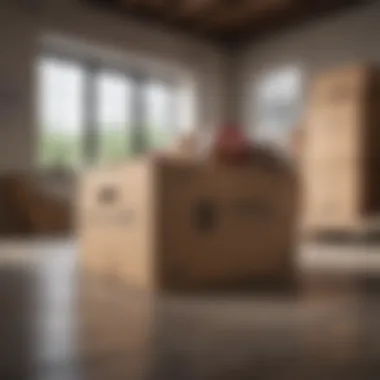Your Comprehensive Checklist for a Smooth Transition into a New Home


Budgeting Techniques
Moving into a new house comes with its fair share of expenses, and it is crucial to set a solid financial foundation. Beginning with creating a personal budget will help you track your income and allocate funds for your new home. It is essential to be diligent in tracking expenses accurately and effectively to avoid overspending and stay within your means. Setting realistic financial goals based on your income and expenditures will guide you in making sound financial decisions with the move.
Savings Strategies
Building an emergency fund should be a top priority when transitioning into a new house. This fund acts as a safety net in case of unexpected expenses or emergencies that may arise during the moving process. Automating savings contributions can streamline the process, ensuring consistent saving habits. Exploring different savings accounts will help you maximize your savings through higher interest rates or better terms, aiding in achieving your financial goals efficiently.
Smart Spending Tips
Distinguishing between needs and wants is essential when settling into a new house. Prioritize essential purchases that are necessary for your comfort and well-being. Utilizing cashback and rewards programs can provide additional savings on your expenses, adding value to your spending. Comparison shopping for significant purchases like furniture or appliances is a savvy way to find the best deals without compromising on quality.
Investment Insights
Understanding the various investment options available is crucial for long-term financial stability. Diversifying your investment portfolio across different asset classes can help mitigate risks and maximize returns. Managing the balance between risk and return is key to building a resilient investment portfolio that aligns with your financial goals.
Financial Planning for the Future
Thinking ahead is imperative when moving into a new house, especially when it comes to financial planning for the future. Basic retirement planning involves setting aside funds for your post-employment years to ensure a comfortable lifestyle. Consider estate planning considerations to safeguard your assets and provide for your loved ones in the long run. Regularly reviewing and adjusting your financial plans is essential to adapt to changing circumstances and market conditions, ensuring financial security and peace of mind.
Initial Planning
Moving into a new house entails a plethora of tasks where meticulous planning plays a pivotal role. In this section, we delve into the significance of initial planning, laying the groundwork for a seamless transition into your new abode. Effective initial planning sets the tone for the entire moving process, ensuring no detail goes overlooked. From setting clear objectives to establishing timelines, every decision made during this phase can significantly impact the overall moving experience.
Set a Budget
Determine your moving budget
Embarking on the journey of relocating to a new house requires a well-defined budget to guide your financial allocations. Determining your moving budget involves a detailed analysis of expenses encompassing packing materials, moving services, and any unforeseen costs. This meticulous approach not only prevents overspending but also helps you remain within your financial constraints. By setting a clear budget, individuals can make informed decisions, prioritize essentials, and avoid any last-minute financial surprises.
Consider additional expenses
In addition to the core moving expenses, considering additional costs is crucial for a comprehensive budget plan. These expenses may include utility setup fees, cleaning services, or temporary storage rentals. By factoring in these additional costs, individuals can avoid unnecessary financial strain post-move. Prioritizing transparency and foresight in financial planning elevates the overall moving experience, leading to a more organized and stress-free transition.
Create a Timeline


Establish key milestones
Establishing key milestones within your moving timeline provides a structured approach to the entire process. These milestones serve as checkpoints for progress, ensuring tasks are completed in a timely manner. From finalizing a moving date to packing deadlines, each milestone contributes to the overarching goal of a successful move. By breaking down the moving timeline into manageable segments, individuals can navigate the process with ease and efficiency.
Schedule tasks accordingly
Scheduling tasks in alignment with established milestones is critical for a well-coordinated move. By assigning specific tasks to designated time frames, individuals can prevent last-minute rushes and minimize stress. This approach allows for better time management, ensuring that each aspect of the move receives the attention it requires. Effective task scheduling streamlines the moving process, making it more methodical and less overwhelming for everyone involved.
For a smooth transition into your new house, meticulous planning, budgeting, and timely execution are the key pillars of a successful move.
Packing and Organization
For any individual embarking on the journey of moving into a new house, the phase of Packing and Organization stands as a crucial pillar in the entire relocation process. It sets the foundation for a smooth and efficient transition, ensuring that belongings are safely transported and easily unpacked at the new residence. The meticulous approach to Packing and Organization not only streamlines the moving process but also minimizes the chances of items getting misplaced or damaged during transit.
Declutter and Donate
When it comes to the arduous task of moving, one cannot understate the significance of sorting through belongings. The act of sorting through belongings aids in decluttering, a process essential in minimizing the items being moved to the new house. By discerning between what is truly essential and what can be discarded or donated, individuals streamline their possessions, making the packing and unpacking process more manageable. The key characteristic of sorting through belongings lies in its ability to simplify the moving process, reducing the overall workload and ensuring that only necessary items make their way to the new residence.
Sort through belongings
Sorting through belongings allows individuals to assess their possessions critically, making informed decisions on what to keep and what to let go of. This strategic approach not only reduces the physical burden of moving but also contributes to a clutter-free living environment post-relocation, fostering a sense of organization and efficiency in the new home. The unique feature of sorting through belongings is its capacity to declutter the living space, enabling individuals to start afresh in their new abode.
Donate or discard unnecessary items
Embracing the choice to donate or discard unnecessary items is a conscientious decision that simplifies the moving process further. By parting ways with possessions that no longer serve a purpose or hold sentimental value, individuals not only lighten their load but also contribute to charitable causes by donating usable items. The distinguishing factor of opting to donate or discard unnecessary items is the sense of fulfillment it brings, knowing that belongings are being repurposed or passed on to those in need.
Label Boxes
In the realm of Packing and Organization, the practice of labeling boxes emerges as a game-changer in facilitating a seamless unpacking experience. Categorizing items for easy unpacking and marking fragile items clearly are cornerstones in ensuring that belongings are handled with care and relocated to their designated spots effortlessly.
Categorize items for easy unpacking
Categorizing items for easy unpacking involves grouping similar items together and labeling boxes accordingly. This simple yet effective strategy expedites the unpacking process, allowing individuals to locate essential items without rummaging through numerous boxes. The advantage of categorizing items for easy unpacking lies in its time-saving nature, enabling a swift and organized unpacking process.
Mark fragile items clearly
The practice of marking fragile items clearly is instrumental in safeguarding delicate belongings during the moving process. By visibly identifying fragile items on boxes, movers exercise caution and handle these possessions with the necessary care to prevent breakage. The favorable characteristic of marking fragile items clearly is its ability to prioritize the safety of delicate items, ensuring that they reach the new destination intact and undamaged.


Essential Supplies
When it comes to moving into a new house, having the right essential supplies is crucial for a seamless transition. From moving boxes to cleaning materials, each item plays a significant role in ensuring your move is organized and efficient.
Moving Boxes and Packing Materials
-### Purchase sturdy boxes
In the realm of moving supplies, the significance of sturdy boxes cannot be overstated. Opting for durable boxes ensures the safety of your belongings during transit. Sturdy boxes contribute immensely to the overall goal of a hassle-free move by providing a secure packaging solution for your possessions. The key characteristic of sturdy boxes lies in their robust construction, which minimizes the risk of damage to fragile items. A popular choice among movers, sturdy boxes offer reliable protection and peace of mind. The unique feature of these boxes is their reusability, making them a cost-effective and eco-friendly option. While sturdy boxes excel in safeguarding your items, one disadvantage could be their weight, potentially adding to the overall load of your move.
-### Stock up on bubble wrap and tape
Bubble wrap and tape are essential components of the packing process, ensuring that your items are snugly secured and shielded from harm. The key characteristic of bubble wrap and tape is their ability to cushion delicate objects and seal boxes effectively. This duo is a popular choice for this article due to their reliable protection capabilities. The unique feature of bubble wrap is its air-filled bubbles, providing a cushioning layer that safeguards items from impact. Likewise, tape's adhesive nature ensures boxes remain tightly sealed throughout the move. While advantageous in their protective functions, a downside could be the environmental impact of disposable bubble wrap if eco-friendly alternatives are not used.
Cleaning Supplies
-### Ensure you have cleaning products
Having the right cleaning products on hand is essential for ensuring your new space is hygienic and welcoming. The key characteristic of cleaning products is their ability to effectively cleanse various surfaces, creating a clean environment for settling in. A beneficial choice for this article, stocked cleaning supplies streamline the post-move cleaning process. The unique feature of cleaning products lies in their diverse formulations designed for specific cleaning tasks. However, a potential drawback could be the chemical composition of some products, requiring proper ventilation during use.
-### Prepare for post-move cleaning
Preparing for post-move cleaning is crucial to leave your new house spotless before unpacking. The key characteristic of this preparation is its proactive approach to tidying up the space before fully settling in. This step is a beneficial choice in this article as it ensures a fresh start in your new home. The unique feature of post-move cleaning involves addressing any lingering dust or debris from the move, creating a clean canvas for personalizing your space. While advantageous for cleanliness, a challenge could be the time and effort required for thorough cleaning depending on the house's size and condition.
Utilities and Services
Moving into a new house entails not only the physical act of relocation but also the crucial task of setting up essential services for a seamless transition. Utilities and Services play a vital role in ensuring your new home is fully functional and ready for your occupancy.
Set Up Utilities
Setting up utilities is a fundamental step in the moving process. It involves transferring or activating crucial services such as electricity, water, and gas to guarantee your comfort and convenience in the new abode.
- Transfer or activate utilities
When relocating, the transfer or activation of utilities ensures continuity of services in your new residence. This process streamlines the transition by avoiding disruptions in essential amenities, fostering a smooth move-in experience.


It is advisable to initiate utility transfers well in advance to prevent service lags and unnecessary stress during the moving period.
- Confirm service providers
Verifying service providers is pivotal in guaranteeing the reliability and efficiency of your utility connections. By confirming service details and arrangements, you secure a stable foundation for your household operations.
Change of Address
Updating your address is a pivotal task post-moving to ensure seamless communication and service delivery.
- Update important contacts
Promptly updating vital contacts with your new address is essential for a streamlined transition. This step aids in maintaining connections and receiving important correspondence without delays or interruptions.
- Redirect mail services
Redirecting mail services to your new address is crucial for preventing any mail mishaps. By availing of this service, you ensure that your postal items reach you at your new location promptly and securely.
For a successful move into your new house, meticulous attention to these Utilities and Services aspects is paramount. By adhering to these guidelines, you can navigate the relocation process with efficiency and ease.
Final Steps
Moving into a new house is a significant event that marks the beginning of a new chapter in your life. After a thorough process of planning, packing, and organization, it is time for the final steps as you transition into your new space. Completing these final tasks will ensure a smooth settlement and a sense of accomplishment.
Inspect the Property
Check for any damages
Prior to settling into your new home, it is crucial to examine the property for any potential damages. This step is essential as it allows you to identify any issues that may have arisen during the moving process. By checking for damages, you can ensure that any necessary repairs are addressed promptly, preventing future complications.
Document existing conditions
Documenting the existing conditions of the property is a vital step in the moving process. By recording the current state of the house, you create a reference point for comparison in the future. This documentation can serve as protection against disputes over property damage or discrepancies that may arise later on.
Unpack and Settle In
Prioritize essential items
When unpacking your belongings, it is important to prioritize essential items. Start with the necessities such as toiletries, kitchen supplies, and bedding to ensure immediate comfort in your new home. By focusing on essential items first, you can gradually unpack the rest of your belongings at a manageable pace.
Personalize your new space
Personalizing your new space is an exciting part of the moving process. Add your personal touch by arranging furniture, decorating, and creating a cozy atmosphere that reflects your style and preferences. By customizing your living space, you can create a sense of belonging and make your new house truly feel like home.







